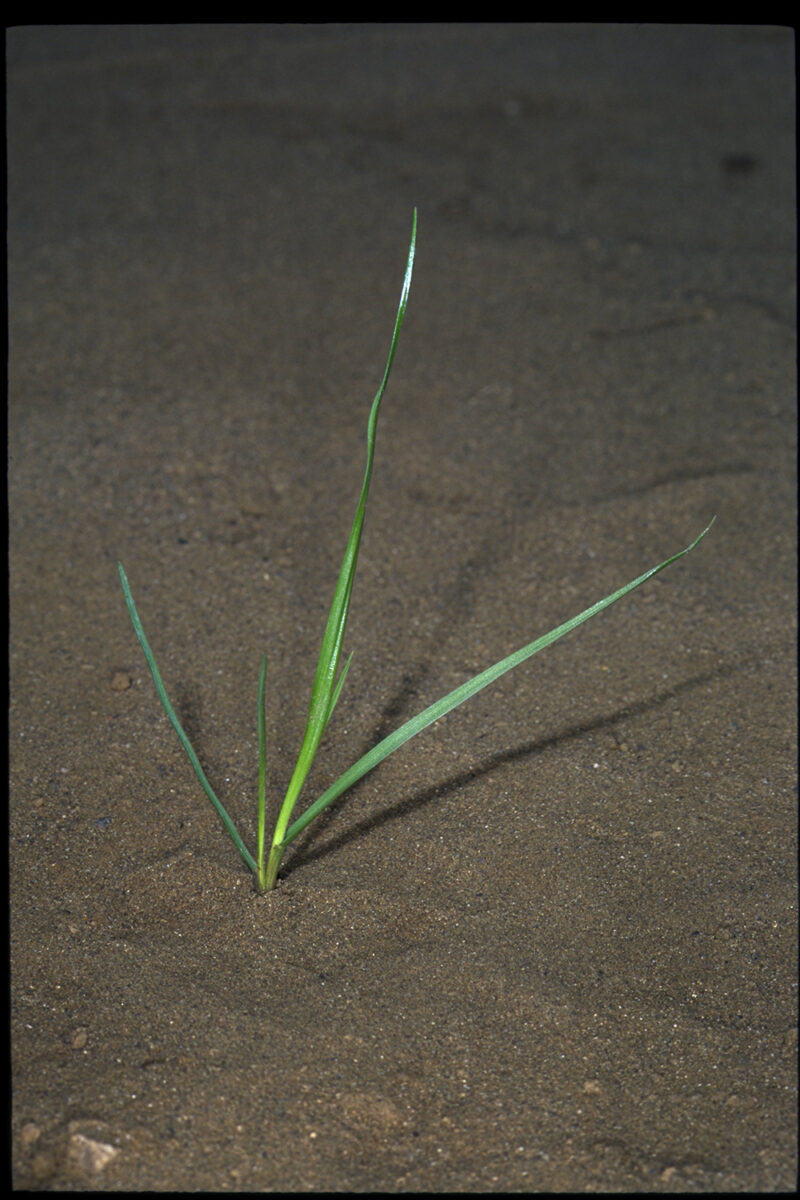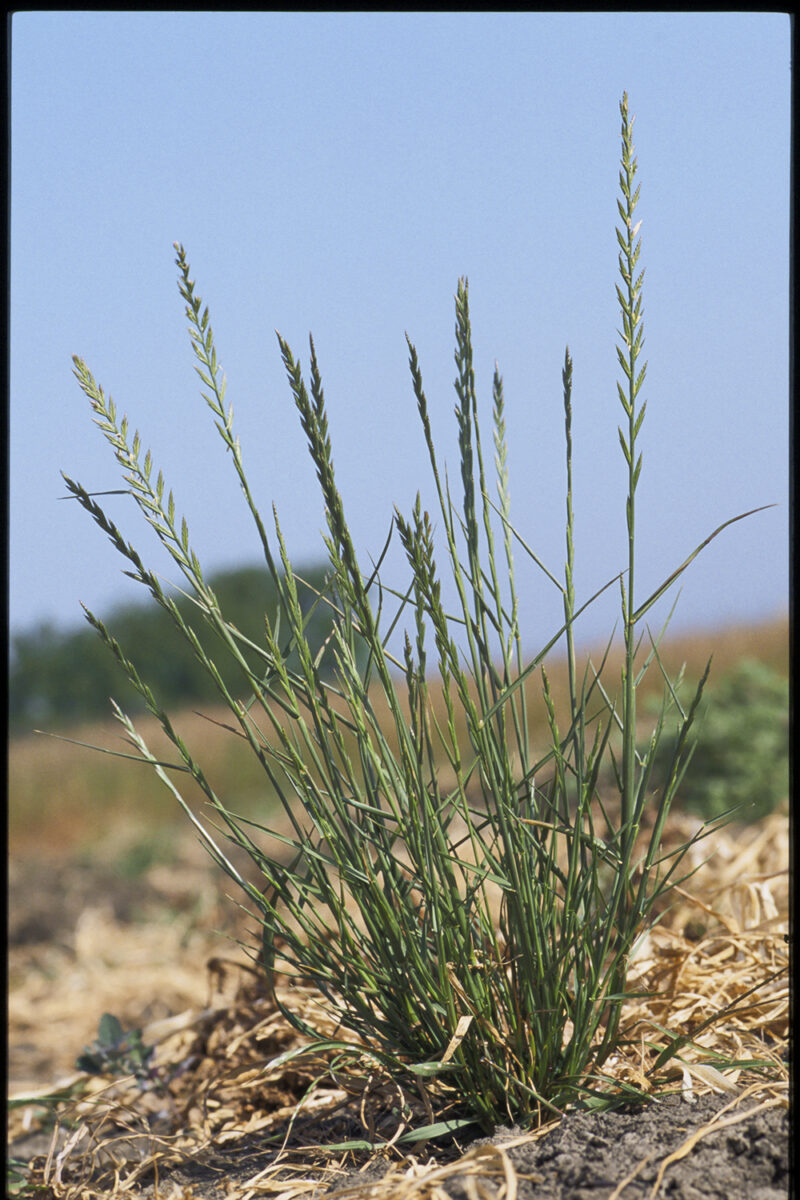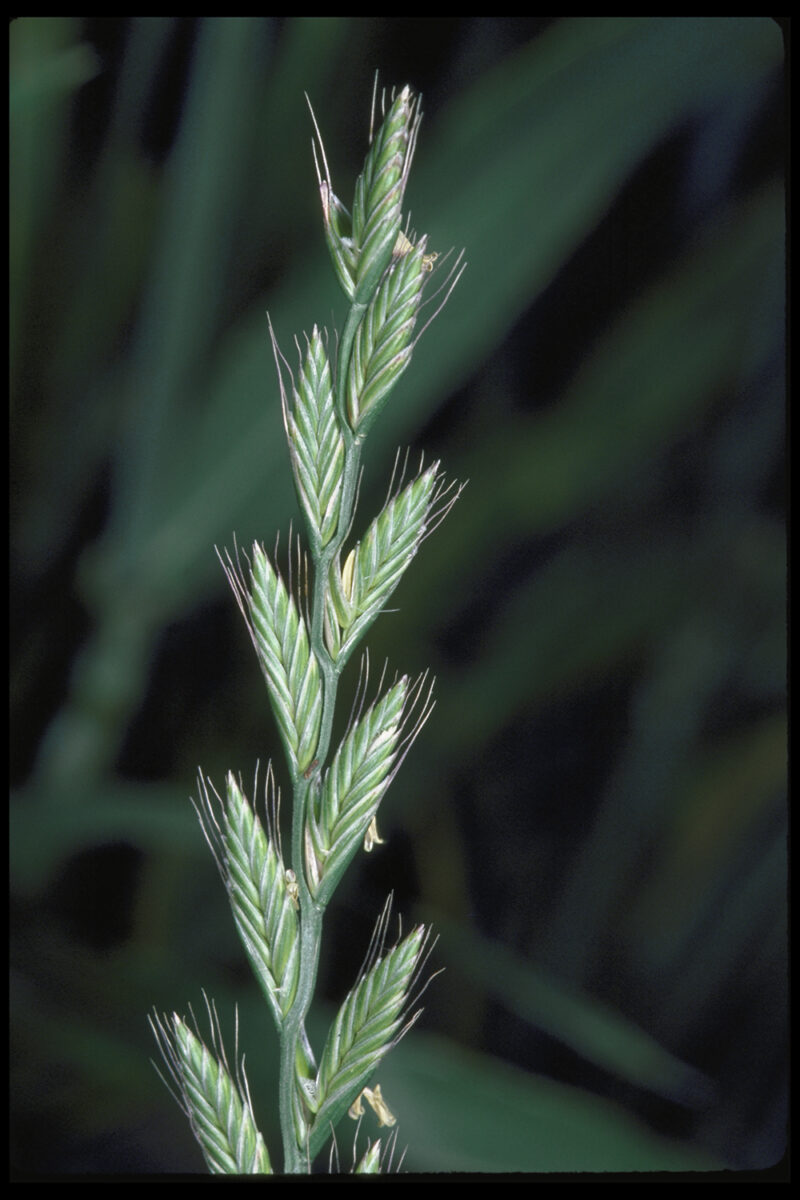Other common names: annual ryegrass, Australian ryegrass, Australian rye



Lolium perenne L. ssp. multiflorum (Lam.) Husnot = Lolium multiflorum Lam.
Identification of Italian Ryegrass
Family: Grass family, Poaceae
Habit: Summer annual, winter annual or biennial bunch grass, or in mild climates like the Pacific Northwest, a short-lived perennial
Description: The seed leaf emerges vertically. The first true leaves of the seedling are rolled in the bud, dark green, have a 0.1 inch translucent ligule and small inconspicuous auricles, and leaf blades are 4–5 inches long by 0.1 inch wide with obvious, raised veins and glossy undersides. Blades and sheaths both lack hairs. Sheaths are red at the base. Mature plants of upright, sturdy Italian ryegrass reach 20–40 inches in height and have a coarse texture. Stems are pale yellow to red at the base; sheaths are round and vary in texture. Older leaf blades measure 4–8 inches long by 0.2–0.4 inch wide and are rough with prominent, raised veins, smooth edges and glossy undersides. The broad collar region has long, slender, claw-like auricles and a flat, translucent ligule that may exhibit light tearing or fringing. Blades are rough with prominent, raised veins, smooth edges and glossy undersides. Inflorescences are flat, with 4–15 inch-long spikes located at the end of stems. Spikelets 0.4–0.7 inch long, containing 10–20 flowers that are attached to the spike alternately so that the length of the spikelet runs parallel to the stem. Spikelets have one thin, papery, 0.3–0.5 inch-long outer chaff attached at the base of the spikelet. Each individual flower has two, 0.4 inch chaffs and one long awn. As with all grasses, seeds are covered by a thin, tight layer of fruit tissue. They are oval and 0.3 inch long, including the chaff but not the long awn. The flattened seed base is encircled by a raised ridge.
Similar species: Perennial ryegrass (Lolium perenne L.) has spikelets that consist of only 6–10 flowers and lacks awns. While the leaves of Italian ryegrass are rolled in the bud, those of perennial ryegrass are folded. Quackgrass (Elymus repens (L.) Gould), a rhizomatous perennial, also has auricles and a flat, terminal spike inflorescence. However, it is distinguishable by its sharp, pointed rhizome tips, longer seedling blades (4–8 inches), very short ligule and two outer chaffs at the base of each spikelet in its inflorescence.
Management of Italian Ryegrass
Italian ryegrass is a serious weed of winter wheat throughout the Southeast, southern Midwest and far West. It grows relatively poorly in hot weather, and it can be controlled effectively in summer row crops with a combination of tine weeding, inter-row cultivation and hilling up of the crop at lay by. Consequently, rotation of winter grains with summer row crops tends to interrupt the life cycle of Italian ryegrass and reduces populations.
Since the seeds die off rapidly and must be close to the soil surface for successful emergence, plowing under the seeds can also aide in long-term control. Tilling under ryegrass seeds on the soil surface greatly reduced density of the weed in a subsequent winter grain crop relative to use of a minimum tillage regimen. However, the seeds produced by a bad infestation may be so numerous that rotating into a hay crop for several years may be required to substantially reduce the seed bank, provided the mowing regimen prevents seed production.
To reduce infestations within grain crops, tine weed before emergence and again when the crop has three leaves. Tine weeding can be done more aggressively if the crop is planted at a consistent depth and if the density of plants in the row is sufficient to deflect the weeder’s tines out of the row. A weeder with stiff, straight or 45-degree-bent tines will work best to break and bury young ryegrass at the post emergence weeding. A relatively high crop seeding rate also has been shown to increase wheat yield and decrease dockage, especially when wheat was planted in a narrow row spacing (3 inches versus 8 inches).
At harvest, use a chaff collection system on the combine or set the combine to collect as many of the ryegrass seeds as possible, and then clean them out of the grain afterward. Although some seeds will shatter to the ground during combining, Italian ryegrass tends to mature later than winter wheat, so most seeds will still be on the plants. Collecting seed with the combine can tip the balance toward long-term control of the weed. The cleanings can be fed to cattle but only after thorough grinding, since a large proportion of any undamaged seeds will pass through the animals’ guts. Incorporate ryegrass stubble immediately after harvest to arrest further seed production. If the field is cut higher than 1.5 inch, graze the stubble to prevent regrowth of the ryegrass. When all other measures fail, some growers harvest small grains infested with Italian ryegrass as a high quality forage to prevent ryegrass seed production.
Many of the tillage, cultivation and crop rotation strategies discussed above apply to vegetable crops as well as to grains. Flush seeds out of the soil with a short fallow before planting cool season vegetable crops. Plastic mulches effectively suppress this weed. Italian ryegrass has been used as a cover crop, but this should be avoided in areas where it is a weed problem. It is adapted to coexist with other winter annual cover crops, but it will continue to grow and set seeds after these other cover crops flower and are mechanically terminated.
Ecology of Italian Ryegrass
Origin and distribution: Italian ryegrass is native to southern Europe, southwest Asia and northwest Africa but has been widely introduced throughout the temperate zones and upland tropics. It now occurs in North America, Australia, New Zealand and South America. In North America, it occurs throughout the United States and Canada, and in Mexico.
Seed weight: 1.3–2.6 mg, with a mean of 2 mg.
Dormancy and germination: Most seeds of Italian ryegrass lack primary dormancy, although some biotypes produce up to 55% dormant seeds. These seeds become germinable after six months of after-ripening. Usually, seeds germinate soon after entering the soil if moisture is sufficient. Seed viability can be as high as 90–95%, although germination rates in the field are often lower than this. Seeds will germinate at temperatures as low as 36°F, with the greatest germination occurring at day/night temperatures from 50/41°F to 77/41°F. When after-ripened, seeds can germinate at daytime temperatures as high as 86–104°F. Light promotes germination of previously buried seeds, but substantial germination can still occur in the dark. Cold (40–50°F), saturated soil conditions tend to preserve seeds in a viable but non-germinating state and induce secondary dormancy. Germination and establishment proceed more rapidly than that of other grasses under cool conditions.
Seed longevity: In undisturbed soil in Oregon, seeds of Italian ryegrass died off at a rate of about 58% per year, and depletion of the seed bank occurred more rapidly in well drained than in poorly drained soil. An experiment in Wales also resulted in an average loss rate of 58% per year. In another experiment in Oregon, an average of only 36% of seeds survived burial for 180 days from October to April, indicating a more rapid rate of seed bank decline.
Season of emergence: Spring seedlings can emerge anytime from March to May, depending upon local conditions. In California and Oregon, emergence usually occurs with the onset of the fall rainy season. Fall emerging plants will function as winter annuals in climates where they survive winter.
Emergence depth: Italian ryegrass emerges best from depths of 0.25–0.5 inch.
Photosynthetic pathway: C3
Sensitivity to frost: Italian ryegrass is sensitive to severe cold but grows as a winter annual in plant hardiness zone 6 and south.
Drought tolerance: Italian ryegrass grows poorly during drought. Growth is also reduced when temperatures exceed 77°F, even when moisture is available. On non-irrigated sites, the fibrous root system can grow to over 3 feet deep, and well-established plants have the potential to tap deep soil water reserves to persist through drought periods. Unlike many other grass species, roots will not regrow after drying out.
Mycorrhiza: Annual ryegrass is a mycorrhizal species.
Response to fertility: Nitrogen is the most critical nutrient for growth of Italian ryegrass, and the species responds favorably to very high N application rates. Annual ryegrass grows well at pH 5–7.8 but does best from pH 5.5–7.
Soil physical requirements: Italian ryegrass is well adapted to a wide range of soil types, from fine to coarse textured. It tolerates saline soil conditions. It tolerates wet soil conditions and can survive flooding for 15–20 days, provided temperatures are below 81°F.
Response to shade: Although some sources list Italian ryegrass as being shade intolerant, the species also has been described as moderately shade tolerant. We have found that it can establish and grow within a cover crop canopy as well as under a closed corn canopy.
Sensitivity to disturbance: Trampling by livestock can kill the plant when the foliage is frosted. Italian ryegrass regrows quickly after mowing if the weather is cool and if the plant is cut above 3 inches. Cutting stems below the growing point, for example at 1 inch, causes the plant to weaken or die. Plants should be mowed or killed before early bloom to prevent seed set.
Time from emergence to reproduction: Fall emerging plants flower in late spring and early summer in Colorado and Montana, but flower in early spring in many other areas. More than 11 hours of daylight are required to initiate flowering. The embryo becomes viable 10 days after pollination, and seeds mature 20 days later.
Pollination: Cross fertilization by windborne pollen is normal, but self-pollinated plants often produce a few seeds.
Reproduction: Drilled, fertilized stands of Italian ryegrass produced 113–121 seeds per inflorescence and roughly 300 seeds per plant. Lower seed production could be expected from plants growing with a competitive crop. Plants do not spread vegetatively.
Dispersal: The chaff has short bristles that probably aid in dispersal on animal fur. About one-third of seeds pass through cattle unharmed and could be dispersed with manure; however, holding the manure in a tank for three months kills the seeds. The species is a contaminant of grass seed unless the seed is produced under strict standards.
Common natural enemies: Mites sometimes damage Italian ryegrass, particularly during dry weather. Crown rust (Puccinia coronata) and gray leaf spot (Pyricularia sp.) are common diseases of the species. Stem rust (Puccinia graminis ssp. graminicola) is common in Oregon but rare in the Southeast. Ryegrass blast (Magnaporthe grisea) can cause substantial damage in the Southeast.
Palatability: Humans do not eat any part of Italian ryegrass. The species makes nutritious forage for livestock, and several million acres are planted with the species, primarily for winter pasture in the Southeast and Northwest. Italian ryegrass can cause annual ryegrass toxicosis, but the disease is rare. The toxic compounds are only produced when the species is infected by the nematode Anguina agrostis and only when this nematode is infected by a bacteria (Clavibacter toxicus), which is itself infected with a virus.
Summary Table of Italian Ryegrass Characteristics
| Italian ryegrass | ||||||||
|---|---|---|---|---|---|---|---|---|
| Growth habit | Seed weight (mg) | Seed dormancy at shedding | Factors breaking dormancy | Optimum temperature for germination (F) | Seed mortality in untilled soil (%/year) | Seed mortality in tilled soil (%/year) | Typical emergence season | Optimum emergence depth (inches) |
| medium | 1.3–2.6 | Variable | li | 50/41 to 77/41 | 58–64 | na | fall and spring | 0.25–0.5 |
| Photosynthesis type | Frost tolerance | Drought tolerance | Mycorrhiza | Response to nutrients | Emergence to flowering (weeks) | Flowering to viable seed (weeks) | Pollination | Typical & high seed production (seeds per plant) |
| C3 | moderate | low | yes | high | 4–8 | 3 | cross, can self | na & 300 |
Table Key
General: The designation “–” signifies that data is not available or the category is not applicable.
Growth habit: A two-word description; the first word indicates relative height (tall, medium, short, prostrate) and second word indicates degree of branching (erect, branching, vining).
Seed weight: Range of reported values in units of “mg per seed.”
Seed dormancy at shedding: “Yes” if most seeds are dormant when shed, “Variable” if dormancy is highly variable, “No” if most seeds are not dormant.
Factors breaking dormancy: The principle factors that are reported to break dormancy and facilitate germination. The order of listing does not imply order of importance. Abbreviations are:
scd = seed coat deterioration
cms = a period subjected to cold, moist soil conditions
wst = warm soil temperatures
li = light
at = alternating day-night temperatures
ni = nitrates
Optimum temperature range for germination: Temperature (Fahrenheit) range that provides for optimum germination of non-dormant seeds. Germination at lower percentages can occur outside of this range. The dash refers to temperature range, and the slash refers to alternating day/night temperature amplitudes.
Seed mortality in untilled soil: Range of mortality estimates (percentage of seed mortality in one year) for buried seeds in untilled soil. Values were chosen where possible for seeds placed at depths below the emergence depth for the species and left undisturbed until assessment. Mortality primarily represents seed deterioration in soil.
Seed mortality in tilled soil: Range of mortality estimates (percentage of seed mortality in one year) for seeds in tilled soil. Values were chosen for seeds placed within the tillage depth and subjected to at least annual tillage events. Seed losses are the result of dormancy-breaking cues induced by tillage, germination and deterioration of un-germinated seeds.
Typical emergence season: Time of year when most emergence occurs in the typical regions of occurrence for each weed. Some emergence may occur outside of this range.
Optimum emergence depth: Soil depths (in inches below the soil surface) from which most seedlings emerge. Lower rates of emergence usually will occur at depths just above or just below this range.
Photosynthesis type: Codes “C3” or “C4” refer to the metabolic pathway for fixing carbon dioxide during photosynthesis. Generally, C3 plants function better in cooler seasons or environments and C4 plants function better in warmer seasons or environments.
Frost tolerance: Relative tolerance of plants to freezing temperatures (high, moderate, low).
Drought tolerance: Relative tolerance of plants to drought (high, moderate, low).
Mycorrhiza: Presence of mycorrhizal fungi. “Yes” if present; “no” if documented not to be present, “unclear” if there are reports of both presence and absence; “variable” if the weed can function either with or without, depending on the soil environment.
Response to nutrients: Relative plant growth response to the nutrient content of soil, primarily N, P, K (high, moderate, low).
Emergence to flowering: Length of time (weeks) after emergence for plants to begin flowering given typical emergence in the region of occurrence. For species emerging in fall, “emergence to flowering” means time from resumption of growth in spring to first flowering.
Flowering to viable seed: Length of time (weeks) after flowering for seeds to become viable.
Pollination: “Self” refers to species that exclusively self-pollinate, “cross” refers to species that exclusively cross-pollinate, “self, can cross” refer to species that primarily self-pollinate, but also cross-pollinate at a low rate, and “both” refers to species that both self-pollinate and cross-pollinate at relatively similar rates.
Typical and high seed production potential: The first value is seed production (seeds per plant) under typical conditions with crop and weed competition. The second value, high seed production, refers to conditions of low density without crop competition. Numbers are rounded off to a magnitude that is representative of often highly variable reported values.
Further Reading
Beddows, A.R. 1973. Biological Flora of the British Isles. Lolium multiflorum Lam. (L. perenne L., ssp. multiflorum (Lam) Husnot, L. italicum A. Braun). Journal of Ecology 61: 587–600.
Justice, G.G., T.F. Peeper, J.B. Solie and F.M. Epplin. 1994. Net returns from Italian ryegrass (Lolium multiflorum) control in winter wheat (Triticum aestivum). Weed Technology 8: 317–323.
Trusler, C.S., T.F. Preeper and A.E. Stone. 2007. Italian ryegrass (Lolium multiflorum) management options in winter wheat in Oklahoma. Weed Technology 21: 151–158.

